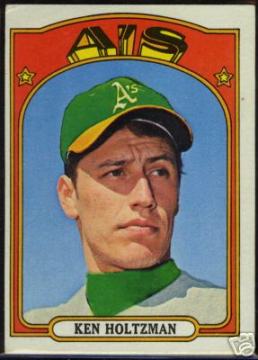Hey, it’s Neidermeyer!
I have to confess I didn’t come up with this original thought; a baseball card dealer who was appraising my collection made the observation that this memorable Topps card (No. 670) made Ken Holtzman look like the sadistic character in Animal House, the 1978 cult film classic. The "real" Doug Niedermeyer, the evil ROTC leader, was played by talented character actor Mark Metcalf, who achieved lesser fame as "The Maestro" on two Seinfeld episodes and also played the father in the introduction to the video for Twisted Sister’s "We’re Not Going To Take It."
Holtzman’s 1972 Topps card, which was his first with the A’s, featured Oakland’s airbrushed green and gold colors over the cap and jersey of the Chicago Cubs. During the winter, the Cubs had traded the left-hander to the Bay, but Topps apparently did not have any updated photographs of Holtzman wearing an A’s uniform at the time of the card’s release. For Holtzman, the offseason trade turned out to the best of all possible career moves. The Cubs’ decision to trade him for outfielder Rick Monday freed Holtzman from the clutches of Chicago’s anti-Semitic manager, Leo Durocher; placed him in the pitcher-friendly environs of the Oakland Alameda County Coliseum; and allowed him to join a team on the verge of winning three consecutive World Championships. Holtzman certainly played a large role in Oakland’s championship run; as the No. 3 starter behind Jim "Catfish" Hunter and Vida Blue, Holtzman won a combined 59 games during his first three seasons in the Bay Area.
Of all the factors affecting Holtzman in Chicago, his relationship with Durocher seemed like the most detrimental. Though a serviceable pitcher with the Cubs, Holtzman sometimes struggled under the brutal management style of Durocher, whose antiquated way of dealing with players undermined the thoughtful left-hander’s performance. According to at least one writer, Durocher repeatedly made anti-Semitic slurs toward Holtzman, even calling him a "kike." Such bigotry didn’t completely end for Holtzman after his trade from Chicago; Billy Martin reportedly expressed anti-Semitic views toward Holtzman when both toiled for the Yankees in 1976 and ’77.
Holtzman thrived pitching for Dick Williams and Alvin Dark during his Oakland says, but he and Martin did not mesh well in New York. While the actual existence and level of Martin’s anti-Semitism remains debatable, there is no debate over the fact that the manager buried the veteran left-hander. After the Yankees acquired Holtzman from the Orioles as part of a ten-man blockbuster in the middle of the 1976 season, he struggled in pinstripes to the tune of a 4.14 ERA, the highest since his Chicago days. Martin lost confidence in Holtzman quickly. In 1977, Martin called on Holtzman only 18 times, and only seven times as a starter. Martin refused to use him down the stretch in critical games. Despite being only 31 years old and only two seasons removed from status as an elite American League left-hander, Martin had about as much confidence in Holtzman as he did in Ken Clay. Or about as much as Yankee fans today have in Kyle Farnsworth.
Now it may not have been Martin working alone. According to some Yankee observers, George Steinbrenner was just as upset by Holtzman’s spotty performance in New York. Disappointed in his 1976 mid-season acquisition, Steinbrenner wanted to trade Holtzman, but there was the little matter of a "no-trade" clause. Holtzman refused to waive the no-trade, drawing the further wrath of The Boss. That decision, coupled with Holtzman’s status as the Yankees’ player rep, may have sent Steinbrenner to the stove. According to some, Steinbrenner ordered Martin to keep Holtzman chained to the bullpen. In contrast to requests to bat Reggie Jackson clean up, Martin was only too willing to acquiesce to Steinbrenner on the matter of burying Holtzman.
Essentially, Martin and Steinbrenner treated Holtzman as "worthless and weak," to borrow Neidermeyer’s favorite catch phrase in addressing his pathetic Animal House recruits. Unfortunately, Holtzman never recovered from the mistreatment. In June of 1978, the Yankees traded him to the Cubs for Ron Davis (now that was a good deal), but the left-hander didn’t come close to resembling his former Chicago self. By the end of the 1979 season, Holtzman was out of baseball, done at the age of 33.
Of course, it’s certainly possible that Holtzman’s early pitching demise resulted from a heavy workload. From 1968 to 1976, Holtzman pitched at least 215 innings per season, with the exception of one. And some of his innings pitched totals were astounding: 266, 287, and 297. I’m not doubting those numbers were a factor in his career decline, but I have to believe that Martin’s handling of Holtzman played a role, too. That kind of emotional damage—whether it’s inflicted by Niedermeyer or the bigots of the world—can be just as destructive as pitch counts and workloads in bringing a career to a premature halt.
Bruce Markusen writes "Cooperstown Confidential" for MLB.com and has authored eight books on baseball, including the upcoming release, Out of Left Field. He can be reached at bmark@telenet.net.



